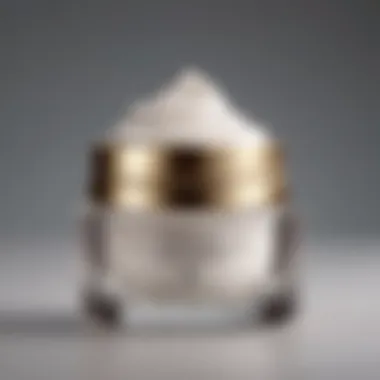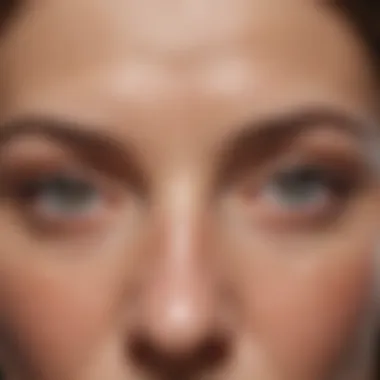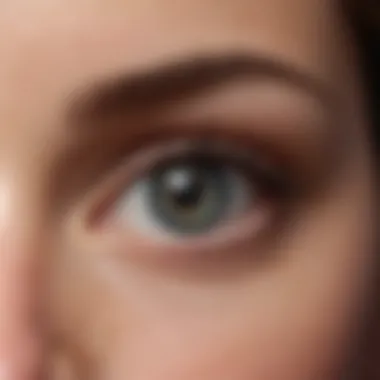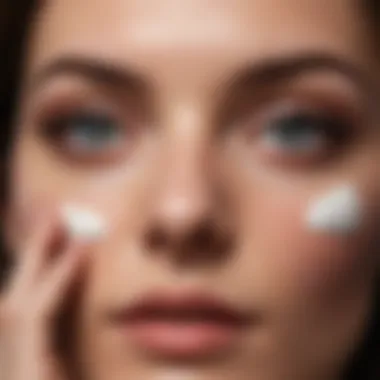Effective Eye Creams to Reduce Wrinkles


Intro
Wrinkles around the eyes can be a persistent annoyance, showing up as fine lines, crow's feet, or simply that tired look. As we age, the skin loses its natural elasticity and moisture, making those delicate areas more susceptible to these signs of aging. But fear not! This article is here to explore a variety of creams aimed specifically at tackling this issue.
Understanding why these wrinkles occur in the first place is crucial. The skin around the eyes is thinner and more fragile than elsewhere on the face, making it more prone to damage. Factors such as sun exposure, environmental pollution, and the natural aging process all contribute to this problem. Knowing the culprits leads us to the next step: identifying key ingredients that can help.
Not all creams are created equal. Ingredients matter, and knowing which ones to look for can drastically change the effectiveness of a product. Some standout components include hyaluronic acid, peptides, and retinol. Each of these plays a unique role in hydration, skin repair, and promoting cell turnover.
In addition to discussing these key formulations, we'll take a close look at the best products on the market today. Reviewers and dermatologists alike weigh in on their favorites. Furthermore, mastering application techniques and adopting preventive measures can play a significant role in preserving skin health.
Ultimately, the goal is to equip readers with knowledge and tools to face their skin care concerns head-on. This comprehensive guide shall unearth not just the latest creams and their workings, but also actionable insights that can seamlessly blend into any skincare routine, keeping your skin looking fresh and youthful.
Understanding Wrinkles Around the Eyes
Understanding wrinkles around the eyes is crucial for anyone who wishes to maintain a vibrant and youthful appearance. These fine lines, commonly referred to as crow's feet, are more than just aesthetic concerns; they can symbolize the toll that life experiences take on our skin. The skin near the eyes is notably delicate, making it more prone to aging signs. Knowledge of this area, along with factors contributing to its wear, can guide individuals in selecting effective creams and treatments.
The Skin Structure Around the Eyes
The skin around the eyes is distinctly different compared to other parts of the face. It is thinner, often measuring only about 0.5 mm, whereas the skin on the cheeks can be up to 2 mm thick. This delicate setup results in less collagen and elastin, proteins that provide structure and elasticity. As we age, these fibers diminish naturally.
Additionally, the skin here lacks oil glands, which means it doesn't produce as much moisture. This dryness can exacerbate the appearance of wrinkles. The thinness makes the area susceptible to the development of dark circles and puffiness. A good understanding of the skin structure invites better choices in skincare products tailored for the eye contour.
Common Causes of Eye Wrinkles
Eye wrinkles can arise from various causes that intertwine to wreak havoc on our skin. One of the foremost culprits is repeated facial movements. Smiling, squinting, and frowning can etch lines into the skin over time. Exposure to sun is another significant factor; ultraviolet rays damage skin cells, accelerating the aging process. It’s not just the sun that plays a role; environmental pollutants also contribute to skin degradation.
Other elements include lifestyle habits—smoking and poor diet may hasten wrinkle formation by restricting blood circulation and reducing the skin's oxygen supply. Inconsistent hydration also plagues many, leading to flakiness that highlights wrinkles. Awareness of these causes empowers individuals to adopt preventive measures against deeper lines forming.
Age and Genetic Factors
Age and genetics are intertwined elements that influence wrinkle formation. As the years pile on, natural processes like reduced collagen production become evident. By the time we reach our forties and fifties, the decline in elasticity is palpable, leading to noticeable wrinkles. Genetics also have a say in how our skin ages. If your family shows a pattern of early wrinkling, you might expect similar outcomes.
Interestingly, people from different ethnic backgrounds may experience aging differently. For instance, individuals with darker skin tones often have more melanin, which provides some natural protection against sun damage. This variety in genetic legacy showcases just how vital one’s background can be in predicting the skin's aging process.
Understanding the dynamics of the skin around the eyes and its susceptibility to aging can guide informed choices when selecting wrinkle creams.
In summary, recognizing the nuances of the skin structure around the eyes, the culprits causing wrinkles, and the role of age and genetics equips individuals with the insights needed for effective skincare. This foundation sets the stage for exploring specific ingredients and products that can offer visual improvements.
Key Ingredients in Eye Creams
Selecting an effective cream for eye wrinkles hinges on understanding the key ingredients that play a vital role in these formulations. Each component contributes uniquely to combating signs of aging, such as fine lines and puffiness. By choosing a product rich in these powerhouse ingredients, you’re not just smoothing out wrinkles; you're also enhancing the overall health of your skin around the eyes, which is often thin and delicate.
Retinoids: The Gold Standard
Retinoids stand as the undisputed champions when it comes to fighting eye wrinkles. Derived from vitamin A, they work by accelerating skin cell turnover, which helps in reducing the appearance of fine lines and wrinkles. Imagine retinoids as a gentle push for your skin to shed the old, damaged cells while promoting the creation of new, more supple ones.
Retinoids can enhance collagen production, leading to firmer and more elastic skin. It’s important to note, however, that not all retinoids are created equal. Some formulations are stronger and might cause irritation, especially around sensitive areas like the eyes. A balanced approach and gradual introduction into your routine can minimize any discomfort.
Peptides: Enhancing Collagen Production


Peptides are tiny chains of amino acids that mend the damaged skin barriers and signal your body to produce collagen. Think of them as the friendly messengers that kick-start your skin’s repair processes. When you incorporate eye creams with peptides, you’re essentially investing in a naturally occurring repair system. These ingredients can reduce the depth of wrinkles and improve skin texture, providing a plumper, smoother look. Furthermore, peptides are usually well-tolerated, making them suitable for various skin types, even sensitive ones.
Hyaluronic Acid: Hydration's Role
The importance of hyaluronic acid cannot be overstated, especially for the skin around the eyes, which often suffers from dryness and lack of moisture. This ingredient acts like a sponge, holding up to 1,000 times its weight in water. It helps to keep the skin hydrated and plump, which, in turn, reduces the visibility of fine lines. Regular use of hyaluronic acid-rich eye creams can lead to a noticeably softer and more elastic area around the eyes. Remember, a well-hydrated skin is a happy skin, making hyaluronic acid an essential component in any cream aiming to combat wrinkles.
Antioxidants: Combatting Free Radical Damage
Antioxidants are your skin's best allies in the fight against free radicals, which accelerate aging and cause skin damage. Ingredients such as vitamin C, green tea extracts, and coenzyme Q10 can neutralize oxidative stress, allowing your skin to maintain its vitality and resilience. By integrating an eye cream that boasts a robust antioxidant profile, you’re giving your skin the tools it needs to combat environmental damage and maintain a youthful glow. This proactive approach not only helps with existing fine lines but can also prevent new wrinkles from forming down the line.
"Incorporating the right ingredients into your eye care routine is like providing a multivitamin for your skin—a necessary nourishment that supports its health and appearance."
By understanding these critical ingredients—retinoids, peptides, hyaluronic acid, and antioxidants—you empower yourself to choose eye creams that genuinely make a difference. Their combined effects can lead to noticeable improvements, ensuring your eye area remains youthful and vibrant.
How to Choose the Right Cream
Selecting the right cream for wrinkles around the eyes is crucial for achieving the desired results. The eye area is sensitive and unique, requiring tailored care. Various factors come into play when making your choice, from your skin type to potential allergies. Knowing how to navigate these considerations can make a world of difference in your skincare routine.
Skin Type Considerations
Understanding your skin type is one of the first steps in finding an effective eye cream. Skin generally falls into several categories: oily, dry, combination, and sensitive.
- Oily Skin: Look for lighter formulations that won’t clog pores. Gel-based products that include ingredients like hyaluronic acid can be very beneficial as they hydrate without added oils.
- Dry Skin: If your skin tends to be on the drier side, choose creams that are richer in texture, preferably containing emollients such as shea butter or natural oils. These ingredients help to lock moisture in and create a protective barrier.
- Combination Skin: For those who have a mix of skin types, a balanced cream that doesn’t lean too heavily toward either end is ideal. Lightweight creams can hydrate without overwhelming any oily spots.
- Sensitive Skin: Individuals with sensitive skin should opt for hypoallergenic creams made without harsh chemicals or fragrances. Look for soothing ingredients like chamomile or aloe vera to calm irritation.
Sensitivity and Allergy Testing
Before fully committing to a product, it’s wise to conduct a patch test, especially if you have sensitive skin or a history of allergies. This test involves applying a small amount of cream to a discreet area and waiting for at least 24 hours to check for adverse reactions. This can save you from the disappointment of a rash or itchiness that might occur from using unsuitable products. If a reaction occurs, it’s best to consult with a dermatologist about your options.
Tip: Always keep in mind that just because a product is popular doesn’t mean it will work for you. Individual reactions can vary widely.
Reading Labels: What to Look for
Once you’ve narrowed down your options based on skin type and sensitivity, develop the habit of reading labels thoroughly. Knowing what’s inside the cream can help you make informed decisions. Here are some key things to look for:
- Active Ingredients: Seek out well-researched ingredients that directly target wrinkles—like vitamin C for brightening, peptides for collagen support, and retinol for cell turnover.
- Avoid Harsh Chemicals: Steer clear of creams that contain parabens, sulfates, or artificial fragrances, as these can irritate the skin, especially in delicate areas.
- Expiration Dates: Always check for expiration dates to ensure you’re getting a product that is effective and safe to use. An expired cream may not only lack efficacy but could also lead to skin issues.
By being mindful of these considerations, you’re on your way to selecting a cream that suits you like a glove. Investing in the right cream will not only enhance your beauty routine but also contribute to healthier, younger-looking skin surrounding the eyes.
Popular Eye Creams Reviewed
When it comes to navigating the world of eye creams, it’s essential to weigh the options available. This section highlights popular eye creams that have garnered positive attention for their effectiveness against wrinkles. With countless products on the market, understanding what sets these popular choices apart is crucial. Often, people gravitate towards specific brands based on reputation, ingredient composition, or price point.
Selecting the right product goes beyond personal preference. It’s about considering your skin type, the consistency of the cream, and how well it fits into your daily skincare routine. Each product mentioned here brings a unique set of benefits, making a meaningful impact on your eye area – a delicate space where care and attention are paramount.
High-end Brands
High-end creams often position themselves as the crème de la crème of skincare. These products typically come with a higher price tag, reflecting their elaborate formulation, research backing, and exclusive ingredient lists. Brands such as Estée Lauder, La Mer, and SK-II offer luxury creams loaded with potent actives aimed at diminishing fine lines and delivering noticeable results.
For instance, Estée Lauder's Advanced Night Repair Eye cream packs powerful anti-aging properties along with hydrating elements that promise to restore tired-looking eyes. The prominent active ingredients, including their patented ChronoluxCB technology, target wrinkles effectively and promote skin renewal for a rejuvenated look.


Consumers often find that these luxury products come with sophisticated packaging and marketing narratives that evoke a sense of indulgence. However, the effectiveness of high-end creams often leads users to justify their investment. Even so, the value derived from these products tends to be subjective, balancing between brand allure and measurable results.
Affordable Options
Not everyone is ready to shell out a fortune for eye creams. Luckily, the market also embraces several affordable alternatives that don’t skimp on quality. Brands like Neutrogena, CeraVe, and The Ordinary provide reliable options that work well without breaking the bank.
Consider CeraVe’s Hydrating Eye Cream, which offers a balanced mix of ceramides and hyaluronic acid to moisturize and plump the skin around the eyes. Its formula caters to a wide audience, from teenagers to those in their fifties, making it versatile for various skin conditions. The affordability of such products allows a wider demographic to partake in effective skincare without going the extra mile financially.
User feedback often applauds these budget-friendly options for their efficacy, leading many to turn away from luxury brands in favor of high-value results.
Botanical and Natural Choices
In an era where the natural beauty movement is on the rise, many individuals are leaning towards botanical and organic choices when it comes to skincare. Products featuring natural ingredients such as rosehip oil, green tea extract, and aloe vera are gaining momentum among eco-conscious consumers.
Brands like Kiehl’s and 100% Pure often craft their formulations with high-quality plant-based ingredients, ensuring that the products are both effective and gentle on the skin. For instance, 100% Pure’s Coffee Bean Caffeine Eye Cream specifically targets puffiness and dark circles while rejuvenating the skin with antioxidants.
The appeal of these natural creams lies in their clean formulations and minimalistic approaches, which resonate with many who prefer sustainable beauty products. However, while these options provide effective results, it is essential to verify that they cater to your specific skin needs.
Remember: Everyone's skin is unique. It’s crucial to find a product that aligns with your personal needs and preferences in skincare.
Application Techniques for Maximum Effectiveness
The effectiveness of eye creams significantly hinges not just on what they contain but also on how they are applied. Proper application techniques can enhance absorption, ensure that the active ingredients penetrate the skin, and maximize the cream’s overall benefits. Using appropriate methods can promote a more youthful appearance and potentially delay the inevitable signs of aging. Here, we shed light on when to apply eye cream and the different methods of application.
When to Apply Eye Cream
Finding the right time to apply eye cream is essential. Typically, most skincare experts recommend using it twice a day: once in the morning and once before bedtime. Applying it in the morning prepares your skin to combat daily environmental stressors, while nighttime use aids in repair and regeneration during sleep. Therefore, it’s prudent to adopt this routine both to keep the skin hydrated and to leverage the skin’s natural recovery processes at night.
Methods of Application
There are various methods to apply eye cream effectively. Two prominent techniques are dabbing versus rubbing, and utilizing tools for application. Each has its unique advantages that can cater to different needs and preferences.
Dabbing versus Rubbing
Dabbing is often favored over rubbing for several reasons. The skin around the eyes is particularly delicate; applying too much pressure can lead to irritation or even tearing of the skin. Dabbing gently with the pad of your fingertip allows for controlled application, ensuring the cream is distributed without tugging at the fragile skin. This technique highlights the gentleness required when dealing with the sensitive eye area, making it a preferred choice for many.
On the other hand, rubbing can create friction, which is less than ideal for promoting healthy skin.
Key characteristics of dabbing:
- Greater control: Minimizes the risk of irritation.
- Better absorption: Dabbing can help the product soak in more thoroughly than rubbing.
This method is generally more beneficial in reducing the potential for skin damage over time, making it a popular go-to for those serious about their eye care routine.
Utilizing Tools for Application
Another increasingly popular technique is using tools for application. Devices such as jade rollers or specialized eye cream applicators are designed to enhance the application experience. These tools can provide a cooling sensation, which not only feels refreshing but can also soothe puffiness—an issue many experience in the morning.
These tools help evenly distribute the product and provide a systematic approach to application. The unique feature of utilizing tools is the ability to engage in a gentle massage, which can stimulate circulation and promote lymphatic drainage, further aiding in reducing the appearance of fatigue and swelling.


Advantages of using tools:
- Enhanced effectiveness: Tools can aid in better absorption and offer additional benefits through massage.
- Convenience and fun: They can make routine more enjoyable and less tedious, encouraging consistent use.
Ultimately, whether you choose dabbing or a specialized tool, what’s important is being consistent in your routine. Remember, gentleness goes a long way—both in application technique and in the results you can achieve.
Additional Preventive Measures
When it comes to addressing wrinkles around the eyes, tackling the issue goes beyond just using the right creams and treatments. Preventive measures play a key role in maintaining skin health and delaying the signs of aging. Incorporating these strategies into your daily routine can enhance the overall effectiveness of your skincare regimen, providing more resilient and youthful-looking skin.
Sun Protection and Its Importance
Sun protection is a cornerstone of any skincare routine, especially for the delicate skin surrounding the eyes. The UV rays can wreak havoc, leading to premature aging, discoloration, and, yes, those unwanted wrinkles. Even on cloudy days, UV rays penetrate the clouds, so it’s crucial to wear sunscreen or protective eyewear whenever you step outside. You can use an SPF 30 or higher specifically designed for sensitive areas, ensuring that you're covering every bit of the skin around your peepers.
Furthermore, donning a wide-brimmed hat can offer extra shielding while adding a touch of style to your outdoor look. It’s a small step with a big impact on your skin’s future.
Lifestyle Changes for Youthful Skin
Diet and Hydration
Diet and hydration are often unsung heroes in the quest for youthful skin. A balanced diet rich in antioxidants, vitamins, and healthy fats can do wonders for your skin's elasticity and suppleness. Foods like berries, leafy greens, nuts, and fatty fish provide essential nutrients that fight against oxidative stress. Maintaining proper hydration levels is equally vital. Water percolates through your system and keeps your skin plump, flushing out toxins that might contribute to premature aging.
Key characteristic: A nutritious diet can drastically improve your skin's health.
Unique feature: While it’s easy to overlook hydration, it’s a simple and effective method to maintain skin elasticity. Remember, you are what you eat.
Sleep and Stress Management
Ensuring adequate sleep and managing stress can positively influence our skin health. During sleep, our bodies indulge in repairing and regenerating, making it a prime time for the skin to recover from daily wear and tear. Chronic lack of sleep can lead to stress-induced wrinkles. Stress management techniques like meditation, yoga, or simply taking time for yourself can contribute significantly to minimizing wrinkles.
Key characteristic: Stress has a measurable effect not just on the appearance but also on the texture of the skin.
Unique feature: Integrating a well-balanced amount of serene moments into your day can make a noticeable difference.
Regular Skincare Routine
Lastly, sticking to a regular skincare routine grounds you in the practice of self-care. A consistent regimen that incorporates cleansing, moisturizing, and targeted treatments helps maintain skin clarity and hydration. Using products that suit your skin type is crucial, and regular evaluation of your routine aids in identifying what works best for you.
By harnessing these additional preventive measures, you create a strong foundation for keeping the skin around your eyes youthful and resilient.
Finale: A Comprehensive Approach to Eye Care
In the quest for youthful skin, the area around the eyes often demands special attention. This region, characterized by its delicate skin, can quickly reveal signs of aging such as fine lines and wrinkles. In this article, we explored various aspects that contribute to effective eye care, culminating in the understanding of why a comprehensive approach is essential.
Recognition of Factors
Understanding the physiological makeup of the skin around the eyes helps us appreciate its fragility. Notably, the thinner epidermis in this area doesn't bounce back as readily as other areas. Combined with factors such as environmental stressors, lifestyle choices, and genetics, the odds stack against maintaining a smooth appearance.
Significant Ingredients
Key ingredients like retinoids, peptides, and antioxidants play roles not just in moisturization but also in promoting long-term skin health. Retinoids can stimulate cell turnover, while peptides enhance collagen production and antioxidants help combat free radicals. A well-formulated cream armed with the right combination of these elements can yield considerable benefits.
"Prevention is better than cure" – a saying that can't be more relevant here.
Application Techniques Matter
The effectiveness of eye creams often hinges on their application. Knowing when and how to apply these treatments can significantly impact their performance. Light dabbing, rather than aggressive rubbing, can ensure that the delicate skin is treated gently while ensuring effective absorption of products.
Preventive Measures Count
Finally, it becomes clear that skincare is not just about products. Sun protection, a healthy lifestyle, and a consistent routine amplify the benefits of creams. Daily habits build the scaffold for enduring skin health, anchoring the notion that comprehensive care addresses both internal and external factors.
In closing, approaching eye care holistically allows one to take charge of skin health. The interplay between high-quality creams, diligent application methods, and smart lifestyle decisions creates a robust strategy to combat visible signs of aging. As the saying goes, why put all your eggs in one basket? By diversifying efforts and being proactive, you’ll stand a better chance at achieving the youthful appearance you desire.







